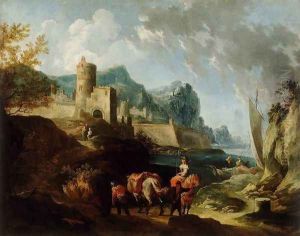Franz Ignaz Flurer Paintings
Franz Ignaz Flurer was a baroque painter born in 1680 in Eichstätt, a town located in the southern German state of Bavaria. In an era marked by the dramatic and emotional intensity of the Baroque style, Flurer's contributions, although less widely known than those of his contemporaries, reflect the richness of the period's artistic expressions. His work, primarily focused on religious and mythological themes, exhibits the characteristic dynamism and attention to detail prevalent among artists of his time.
Flurer's artistic journey began in his hometown, where he was initially exposed to the flourishing artistic environment of southern Germany. This region was a significant cultural hub during the Baroque era, hosting numerous artists whose works contributed to the period's opulent and grandiose aesthetic. Flurer received his early training from local masters, which grounded his technical skills and introduced him to the stylistic elements that would define his career. His talent and dedication to his craft soon led him to seek broader experiences, possibly traveling within Germany and possibly to Italy, a common destination for artists of his time seeking to study the Renaissance and Baroque masters.
Throughout his career, Flurer developed a distinctive style that combined the dramatic lighting and emotional intensity typical of the Baroque period with a meticulous attention to detail. His religious paintings, in particular, were noted for their ability to convey deep spiritual themes through dynamic compositions and vivid portrayals of biblical scenes. Flurer's works were primarily commissioned by the church and by wealthy patrons, which was the norm for artists of his era, allowing him the opportunity to contribute significantly to the decoration of several churches and public buildings.
Despite his contributions to the Baroque movement, Franz Ignaz Flurer remains a somewhat obscure figure in art history. Detailed records of his life and works are scarce, and much of what is known has been pieced together from church records, commission documents, and the surviving examples of his art. His death in 1752 marked the end of a career that, while not as celebrated as some of his contemporaries, contributed to the rich tapestry of Baroque art. Today, Flurer's surviving works offer valuable insights into the religious and cultural contexts of his time, embodying the complexity and grandeur of an era that continues to fascinate art historians and enthusiasts alike.
